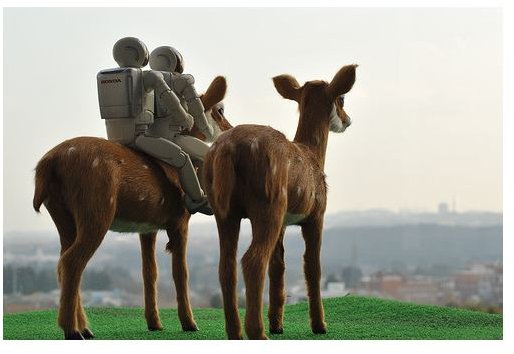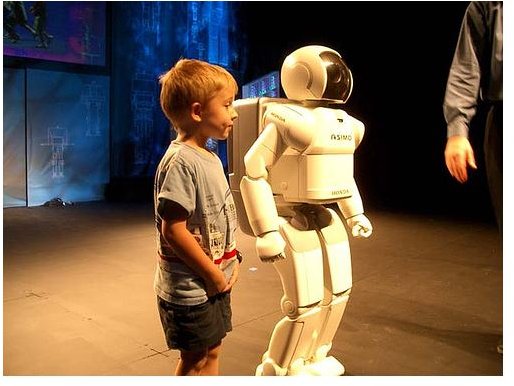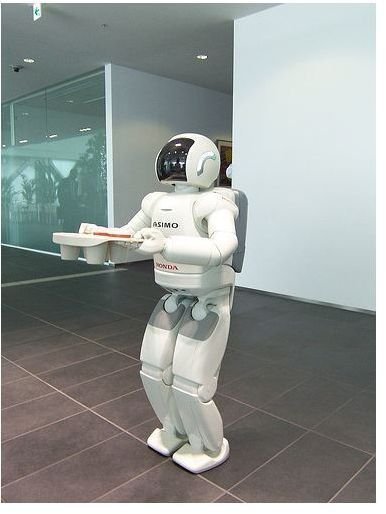When Can I Buy a Robot for my Home?
What is ASIMO?
Being an assistant to people was the idea in mind when ASIMO (Advanced Step in Innovative MObility) was being created. ASIMO, which is 4’ 3” or rather 130 centimeters tall, is a perfect helper in and around a house and can also help a person who is restricted to bed or a wheel chair. The size of this robot makes it easier to directly communicate with a person who is either sitting on his/her bed or a chair.
Actually ASIMO is an extremely stylish piece of equipment, technically speaking. As a marketing tool, ASIMO is creating a sensation, assuring a volley of news reporting with each promotion stunt. Honda had in mind selling units as domestic servants when they actually brought out the robot in 2002.
A robot having the capability to walk up and down stairs, clasp objects, and work together with humans looks like an ideal fit for elderly care. Six years later the cost of Asimo still remains at more than $100,000 to rent. The human roboid has not yet made anyone’s bed and constitutes just the most recent in a chain of letdowns for future household bots. So with what Asimo can and cannot do, the question is when will this robot get a job?
Isaac Asimov’s “Three Laws of Robotics” states that:
- A robot may not injure a human being or, through inaction, allow a human being to come to harm.
- A robot must obey orders given it by human beings except where such orders would conflict with the First Law.
- A robot must protect its own existence as long as such protection does not conflict with the First or Second Law.
A key factor of Asimov’s Three Laws is that they are changeless. He actually anticipated a robot brain of huge complexity that could only be created by humans at the mathematical level. Consequently, the Three Laws are not in the textual form demonstrated above, but were programmed in mathematical terms straight into the center of the robot brain. This programming could not alter in any important way during the course of the robot’s life. Asimov had actually assumed that a robot would be programmed with all things it required to operate before its activation.
Thus the name ASIMO can be easily associated with Asimov, the iconic science-fiction writer who visualized intelligent humanoid robots in his tales and was the first to establish the three laws of robotics, controlling human-machine interactions.
Asimo serving drinks
RIBA, the robot nurse
“RIBA” stands for Robot for Interactive Body Assistance and is perhaps the first robot that can pick up or lay down a real human weighing up to 61kg/134lbs from or to a bed or wheelchair. Oddly, this is a robot that requires a human assistant. RIBA uses its very firm human-like arms and by novel perceptible direction methods applying high-accuracy tactile sensors, is able to do most of the jobs that a nurse does. RIBA could establish its worth when you acquire one, but before you buy RIBA just consider the number of times patients in your hospitals and care institutions are lifted and moved every day. This would also relieve the many care-givers who ultimately fight back bad backs, injuries, and exhaustion. Apart from this the patients will no longer suffer from poorly-executed moves.
Are we safe from robots thinking for themselves?
Robots which can think for themselves in the future would be available for minding our children and the aged and patrolling our streets, say experts. Scientists state that a new generation of robots working without human counsel is in the making. Apart from this in about five years robots can be seen working in care homes, monitoring prisons and helping police in tracing criminals.
Alan Winfield, professor of electronic engineering at the University of the West of England in Bristol, said “it would not be long before technological advances made it possible for robots to be introduced in the home, as well as prisons and the police service.”
Further, while speaking at a debate on robot ethics at the London Science Media Centre, he said, “It is highly likely that in a number of years robots will be employed both for child-minding and care for the elderly. But the danger is that we will sleepwalk into a situation where we accept a large number of autonomous robots in our lives without being sure of the consequences. The outcome could be that when given a choice the robot could make the wrong decision and someone gets hurt. They can go wrong just like a motor car can. We should be aware of the future that we are letting ourselves in for. We need to look at their safety and reliability.” The predictions of the professor could be seen in the hit Hollywood sci-fi film I-Robot, in which a slave robot having a mind of its own causes pandemonium.
The major boosts in robotics in current years have been as arms of war. The U.S. military is building up battlefield robots that will have the capacity to make a decision as to when lethal force has to be used. At the Georgia Institute of Technology in Atlanta, a battlefield robot has been trained to use radar data and intelligence feeds and to make decisions based on a set of moral rules.

Drawbacks
Even though at some point of time in the future robots may fit into the picture drawn by us, nothing can be perfectly said as of now. Regardless of the fact that robots are not alive, numerous delicate actions have been attributed to Asimo’s poses, which were added to conquer the next barrier - the emotional one. Robots are made to look safe in order that we don’t imagine a cold calculating heartless being moving around in our homes chopping vegetables, holding boiling water, or sitting in rest/recharge mode next to us on the sofa.
So if the robot does all of our household work, should we as family members only sit and watch TV or sleep? Robots like Asimo try to generate a fantasy that is not essentially human, but something else that is roughly a cartoon-like overstated description of human mannerisms.
Even though at some point of time in the future robots may fit into the picture drawn by us, nothing can be perfectly said as of now. Regardless of the fact that robots are not alive, numerous delicate actions have been contributed in Asimo’s poses, which were added to conquer the next barrier - the emotional one. Robots are made to look safe in order that we don’t imagine a cold calculating heartless being moving around in our homes chopping vegetables, holding boiling water, or sitting in rest mode next to us on the sofa.
If robots help us and in industries do the job more effectively and efficiently, then what about us? Do we become useless? If the robot replaces the human job, there will be no long queue for job applications from the human later resulting in the increase of unemployment rate. This is indeed debatable!
Conclusion
Now the time has come to decide whether Asimo and future generations of robots will merge comfortably well into homes when they are more easily available to the general populace. Or will there be a revolt against machines working separately without the straight physical direction of human hands? One thing is for sure: precisely as computers were applied in styles that most exposed humanity’s factual personality, robots will tell us to a greater extent about ourselves in an unimaginable way. Asimo is equipped to bond your family. What can he do? It is left to the purchaser to decide, but the rule of Caveat Emptor has to be followed in the process.
So when can you buy a robot for the home? Right now! You can get an Asimo for only $1 million.
References
Jeff Salton - RIBA the friendly robot nurse
Stuart Fox, Popular Science - Robotic Bear Nurse to Help the Elderly in Japan
Erik Sofge - The Problem with Asimo
Rebecca Camber - Are we safe from robots that can think for themselves?
Image courtesy:
Ms. President - Is this all there is to life?
Yasuhiko Ito - ASIMO and Big Doe
Digitalshay - Asimo and New Friend
Just for fun you can watch this video of Asimo and his friend:
https://www.youtube.com/watch?v=agx9vtuvY-M
Asimo and new Friend

